The ASUS TUF X99 Sabertooth Review
by Ian Cutress on July 22, 2015 10:00 AM EST- Posted in
- Motherboards
- Asus
- TUF
- X99
Gaming Performance 2015
Alien: Isolation
If first person survival mixed with horror is your sort of thing, then Alien: Isolation, based off of the Alien franchise, should be an interesting title. Developed by The Creative Assembly and released in October 2014, Alien: Isolation has won numerous awards from Game Of The Year to several top 10s/25s and Best Horror titles, ratcheting up over a million sales by February 2015. Alien: Isolation uses a custom built engine which includes dynamic sound effects and should be fully multi-core enabled.
For low end graphics, we test at 720p with Ultra settings, whereas for mid and high range graphics we bump this up to 1080p, taking the average frame rate as our marker with a scripted version of the built-in benchmark.
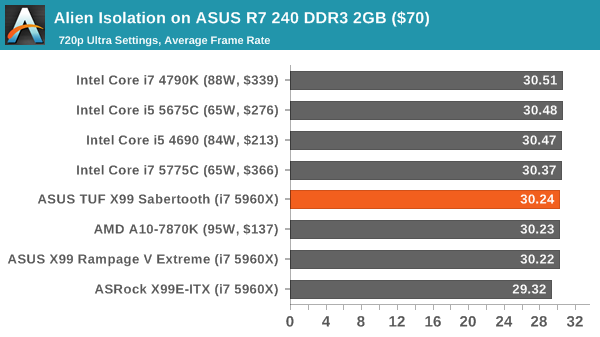
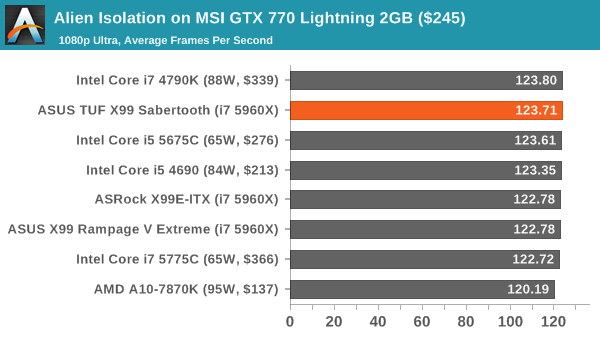
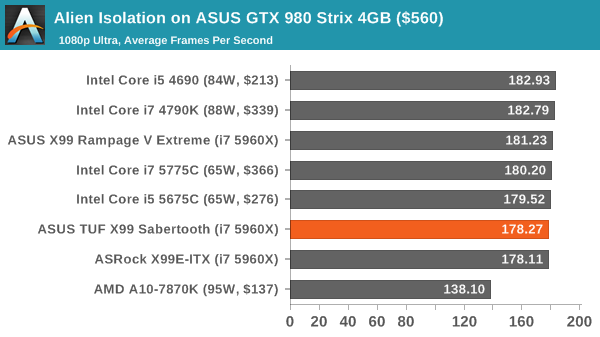
Total War: Attila
The Total War franchise moves on to Attila, another The Creative Assembly development, and is a stand-alone strategy title set in 395AD where the main story line lets the gamer take control of the leader of the Huns in order to conquer parts of the world. Graphically the game can render hundreds/thousands of units on screen at once, all with their individual actions and can put some of the big cards to task.
For low end graphics, we test at 720p with performance settings, recording the average frame rate. With mid and high range graphics, we test at 1080p with the quality setting. In both circumstances, unlimited video memory is enabled and the in-game scripted benchmark is used.
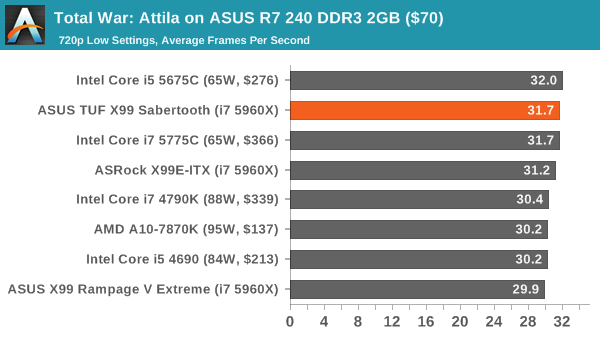
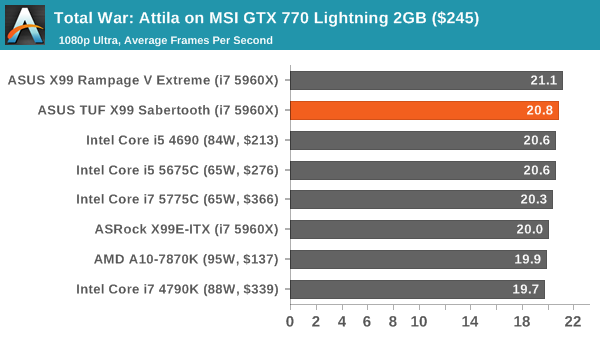
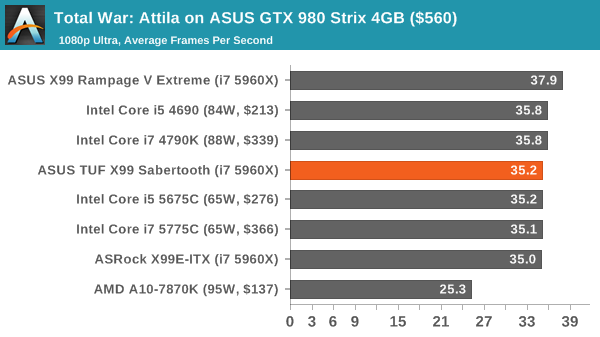
Grand Theft Auto V
The highly anticipated iteration of the Grand Theft Auto franchise finally hit the shelves on April 14th 2015, with both AMD and NVIDIA in tow to help optimize the title. GTA doesn’t provide graphical presets, but opens up the options to users and extends the boundaries by pushing even the hardest systems to the limit using Rockstar’s Advanced Game Engine. Whether the user is flying high in the mountains with long draw distances or dealing with assorted trash in the city, when cranked up to maximum it creates stunning visuals but hard work for both the CPU and the GPU.
For our test we have scripted a version of the in-game benchmark, relying only on the final part which combines a flight scene along with an in-city drive-by followed by a tanker explosion. For low end systems we test at 720p on the lowest settings, whereas mid and high end graphics play at 1080p with very high settings across the board. We record both the average frame rate and the percentage of frames under 60 FPS (16.6ms).
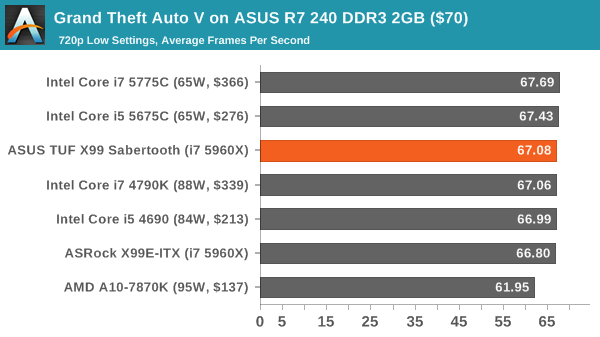
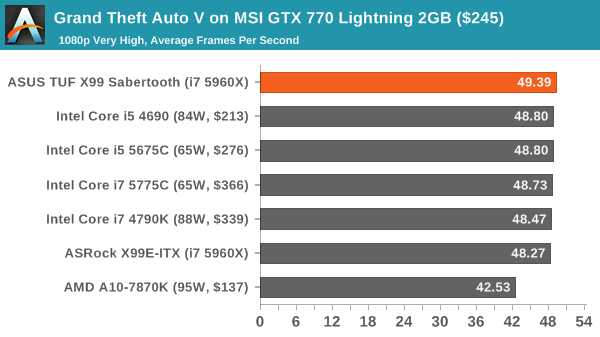
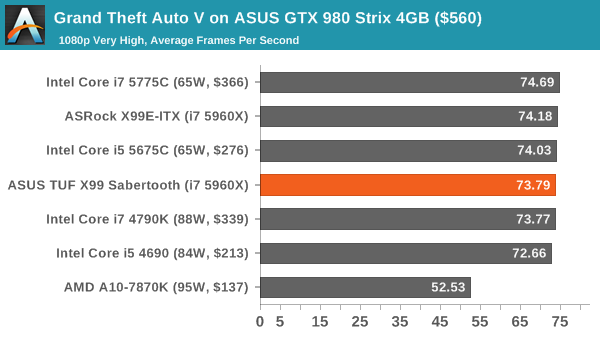
GRID: Autosport
No graphics tests are complete without some input from Codemasters and the EGO engine, which means for this round of testing we point towards GRID: Autosport, the next iteration in the GRID and racing genre. As with our previous racing testing, each update to the engine aims to add in effects, reflections, detail and realism, with Codemasters making ‘authenticity’ a main focal point for this version.
GRID’s benchmark mode is very flexible, and as a result we created a test race using a shortened version of the Red Bull Ring with twelve cars doing two laps. The car is focus starts last and is quite fast, but usually finishes second or third. For low end graphics we test at 1080p medium settings, whereas mid and high end graphics get the full 1080p maximum. Both the average and minimum frame rates are recorded.
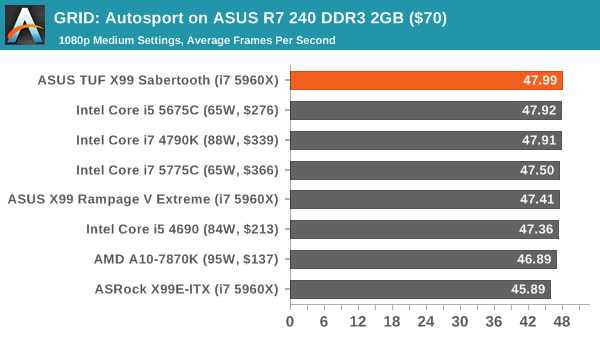
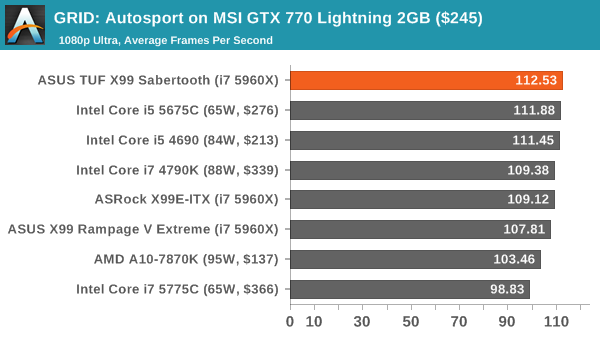
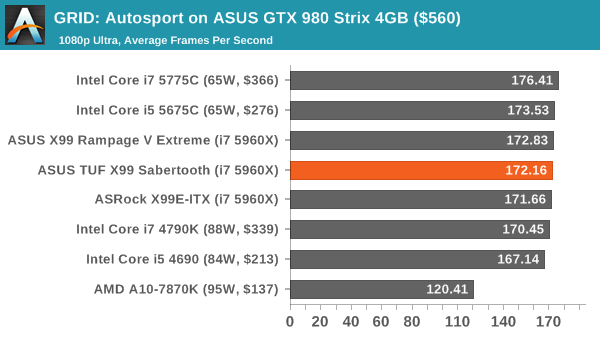
Middle-Earth: Shadows of Mordor
The final title in our testing is another battle of system performance with the open world action-adventure title, Shadows of Mordor. Produced by Monolith using the LithTech Jupiter EX engine and numerous detail add-ons, SoM goes for detail and complexity to a large extent, despite having to be cut down from the original plans. The main story itself was written by the same writer as Red Dead Redemption, and it received Zero Punctuation’s Game of The Year in 2014.
For testing purposes, SoM gives a dynamic screen resolution setting, allowing us to render at high resolutions that are then scaled down to the monitor. As a result, we get several tests using the in-game benchmark. For low end graphics we examine at 720p with low settings, whereas mid and high end graphics get 1080p Ultra. The top graphics test is also redone at 3840x2160, also with Ultra settings, and we also test two cards at 4K where possible.
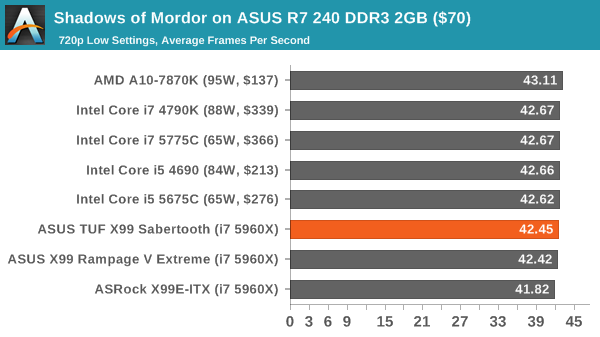
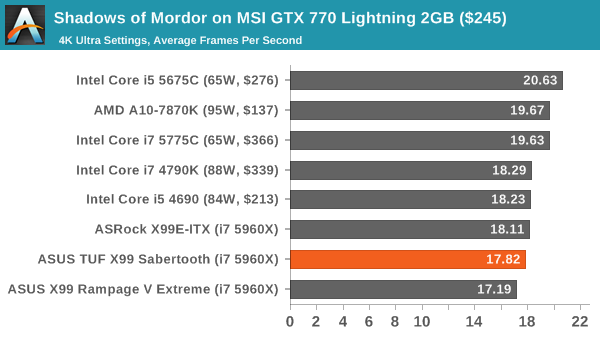
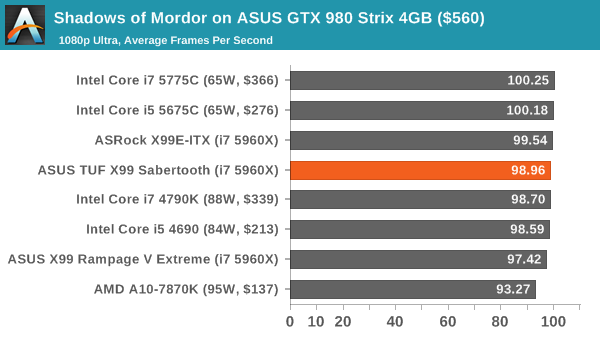
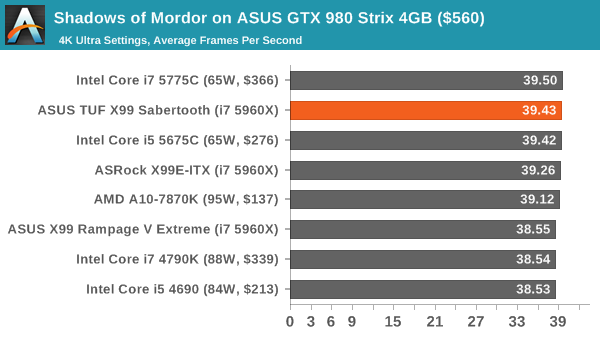
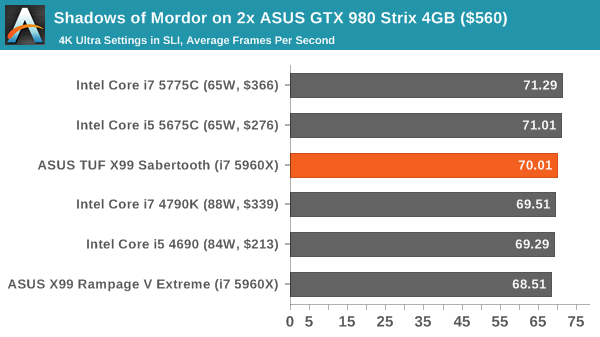


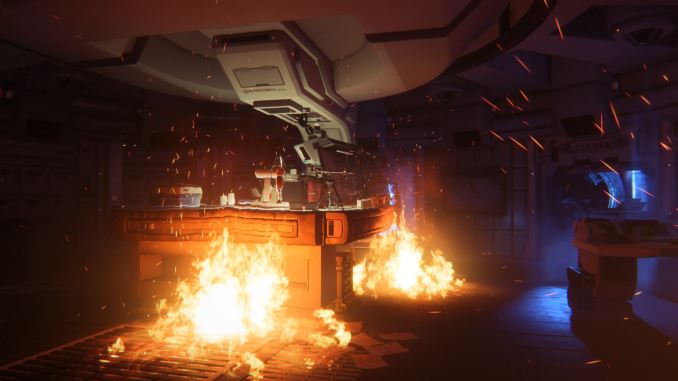
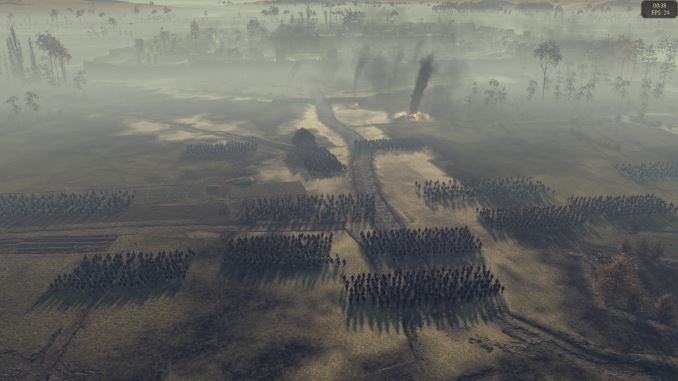
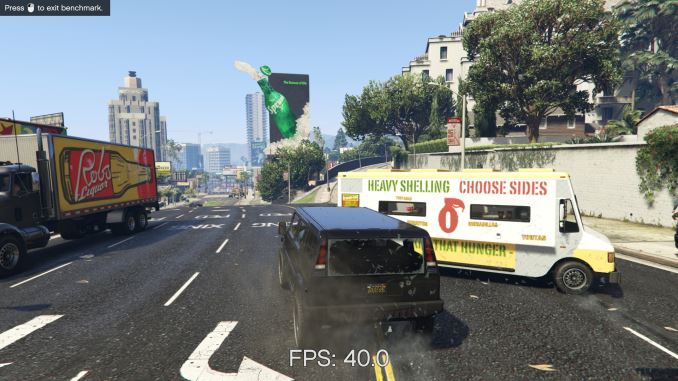
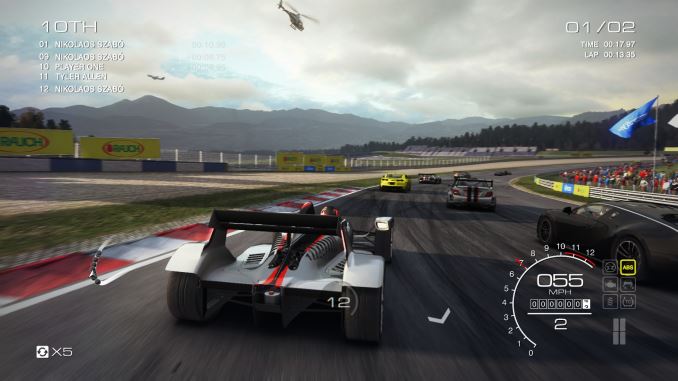
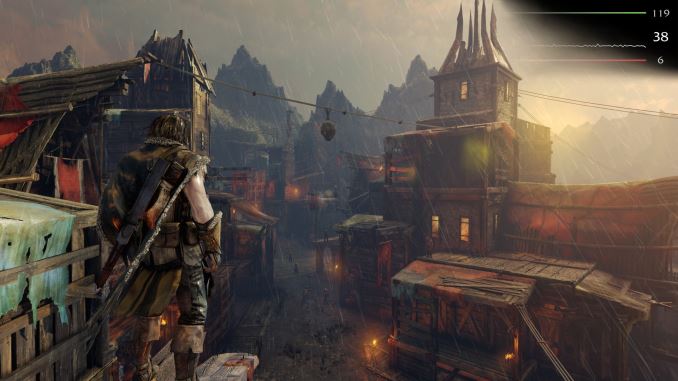








57 Comments
View All Comments
Ryangadz - Friday, July 31, 2015 - link
Also, the work being done in architectual renderings within gaming engines is super impressive. If you aren't familiar with Unreal Engine 4's lighting system its definitely worth looking into. I don't do much in the way of rendering stills anymore because interactive is so much more useful to clients and consumers. Client want to add 10 more desks to an office? Not a problem just move the wall and (even procedurally) drop in more desks all with real-time lighting. Its getting to the point where even I have trouble discerning real v. Baked GI v. Real-time faked GI. Do you think the client can tell... Or even cares?OldCOP - Tuesday, September 8, 2015 - link
A dyslexic renderest, how interestingisamudysan - Tuesday, August 25, 2015 - link
HAHAHAHAHA!!!! 6 x99 boards for years?!!! didn't know x99s were made years ago; and, where's your proof of these 6 x99s that has been running flawlessly for years?"without giving a source this is even more likr UFO sightings....."
LOL
Pinhead* - Thursday, November 5, 2015 - link
I agree! I built with three Asus X99 Deluxe board in the past year and they are all running beautifully. Someone is overclocking and blaming their mistakes erroneously on the boards...MeeDeeGee - Friday, October 8, 2021 - link
I've been running two ASUS X99 boards for years. Never had a problem and the boards are awesome. ASUS ROG X99 Strix with an i7-6950X 10-Core and ASUS TUF X99 Sabertooth with an i7-6800K. Excellent quality and reliability.I read the posts that you linked and the guys are idiots, they were overclocking, so it serves them right to fry things. I never overclock because it is a waste of time (yeah like you really will notice that extra 2% more benchmark numbers in real world applications). Plus it voids your warranty, and wears out your components faster. Serves them right. There is nothing wrong with the ASUS X99.
Zinc64 - Wednesday, July 22, 2015 - link
Didn't bother checking the TUF Detective app?Seems like a neat tool for anyone with a tablet lying around...
LordanSS - Wednesday, July 22, 2015 - link
I hope someday be able to get one of these for a future build... whatever comes after Skylake maybe? Who knows.Most of my issues are not from dust gathering inside (dust filters + positive pressure alleviates most of that problem) but humidity instead.
It's quite difficult for one of my systems to live through 2 years. My Ivy Bridge i7 proc will complete 3 years in a few months, but I already had to replace the motherboard (was an Asus P8Z77-V) a couple months ago. Sadly, Brazil doesn't get the nice warranty periods and RMA possibilities that US customers have. We do get very high humidity tho! =/
ericloewe - Wednesday, July 22, 2015 - link
Realtek 8111 as the second GbE controller? What the hell were they thinking?!lmcd - Wednesday, July 22, 2015 - link
That's as the first GbE controller ;) Likely bundled with the RealTek 1150 solution.steve4king - Wednesday, July 22, 2015 - link
The "Thermal" armor concerns me as it seems like it would be more of an insulator than anything. Unless there ducting to force air under the plastic, it will just block airflow to the motherboard's smaller components.